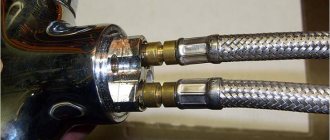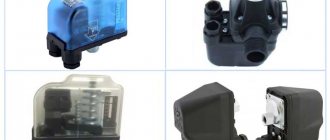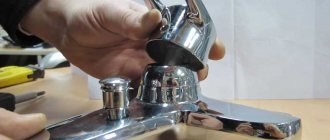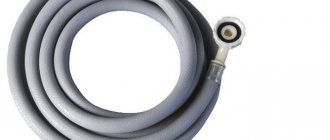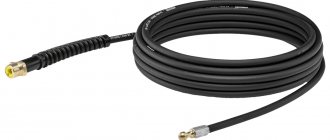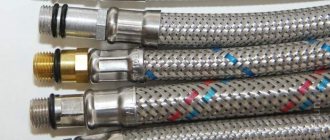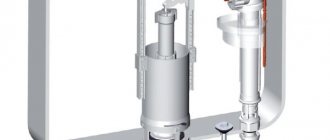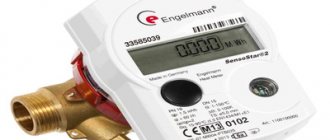At the final stage of plumbing work, faucets, shower stalls, wall-mounted toilets and bidets or other equipment are connected to the water supply system. This can be done using a rigid, bellows or flexible liner. The first option is much more reliable than the last two, but more labor-intensive; in addition, its execution requires not only the presence of a specialized tool, but also the skills to work with it. Therefore, bellows and flexible hoses (for example, hoses for kitchen faucets with a pull-out or pull-out shower head, shower, etc.) are more practical in everyday life.
What is flexible eyeliner?
First of all, it is necessary to emphasize that although this option for supplying water is considered budgetary, it is quite reliable, provided that the materials are correctly selected and the connection technology is followed.
In essence, a flexible water supply is a rubber hose (the same as a watering hose) placed in a tight-fitting braid made of metal threads. Its main purpose is protection against mechanical damage, both external and internal. The latter may occur due to water hammer. In accordance with the standards, such connecting hoses must be designed for a pressure of at least 10 atm.
Below is an example of connecting a herringbone kitchen sink faucet with flexible hoses (A) used to supply cold and hot water.
Connection example using flexible hoses
Please note that the sink siphon is connected to the sewer with a corresponding flexible connection (B).
Purpose
Connectors made of flexible material are used to connect various plumbing fixtures to water pipes.
By and large, the scope of application of these products is much wider; they are actually seen in arbitrary pipelines:
- gas,
- technical,
- automobile, etc.
But within the framework of our article, we are looking at only the plumbing segment of their application.
So, a flexible lead is used to connect the following devices:
- Taps and mixers;
- Boilers;
- Shower cabins;
- Washing cars;
- Dishwashers;
- Pumps and pumping stations;
- Gas water heaters and boilers;
- Toilets, bidets, toilet installations.
Why has this type of pipe become so widespread? Everything is quite simple: using a flexible hose, it is possible to connect any device without connecting steel or plastic pipes exactly to the connection point, since for this you often have to not only cut and weld metal, but also tap the walls.
Along with this, each inaccuracy will lead to the fact that the work will need to be redone or the device moved, which is very undesirable.
In addition, quite often the faucet is connected in hard-to-reach areas, especially in small bathrooms with a clutter of pipes and various devices. The use of a flexible supply eliminates all such troubles, since it can be laid virtually anywhere and along the most winding route.
At the repair stage, you just need to remove the water sockets from the wall or floor near the intended installation location of the washbasin. After this, you match the length of the liner and connect the mixer to the pipes.
Note! Hoses are prohibited from being used as a replacement for main and distribution pipes. In addition, it is not advisable to use them in heating systems to connect radiators.
Kinds
These water hoses come in the following types:
- for connecting the washbasin mixer, shower cabin and other equipment to hot water. To identify them, red threads are added to the braid (“A” in Fig. 2);
- for connection with cold water supply pipes. Their braid contains blue threads (“B”);
- universal, allow connection to any type of water supply. The braid of such pipes is marked red and blue (“C”).
Rice.
2. Hoses for cold and hot water, as well as universal ones. In addition, the hoses differ in the braid material, which is reflected in certain characteristics, namely:
- Aluminum reinforcement. Currently practically not used. The only advantage is the low price, which is not justified due to the short service life (3 years). In addition, such protection cannot withstand pressures of more than 5 atm. But the main drawback of such products is their instability to corrosion. In a damp room, the braid quickly deteriorates, after which the rubber hose quickly becomes unusable. Therefore, such pipes can be used when connecting kitchen equipment, for example, a mixer with a pull-out shower head (with a flexible hose), but they are not suitable for a bathroom or shower.
Aluminum braided eyeliner - Stainless steel braid (the most common type). This design option significantly extends the service life (a high-quality product can be used for at least 10 years). These pipes can withstand a pressure of 10 atm and they have no restrictions on the type of premises, that is, installation is allowed even in a steam room.
Stainless steel braided eyeliner - Nylon braiding significantly improves performance. Such products can be used for 15 years, and they are designed for pressures of up to 20 atm and a temperature of the technical environment of 110°C. True, the cost of these pipes is higher than that of the two previous types. In domestic conditions, there is no need for such high performance, so it is not advisable to use eyeliner with nylon braid.
Nylon braided liner
There are pipes where the hoses are made not of rubber, but of rubber; such products are more reliable, but also much more expensive.
As additional protection, the braid can be coated with a silicone layer, according to manufacturers, this allows the service life to be extended to 20 years.
Bellows liner.
Despite the fact that it is also physically flexible, it is customary to distinguish this type of eyeliner as a separate type, due to significant design differences. The peculiarity of the bellows liner is that the shell is a metal corrugation, strong, but at the same time flexible; in addition, there is no rubber hose inside.
Bellows liner
It is also worth noting that the fitting together with the terminal clamp are connected to the corrugated hose by welding, this significantly increases the reliability of the design. The service life of products of this type is at least 25 years, and they can be used to work with process environments heated to 250°C. As a rule, corrugation is made of stainless steel, but there are VIP category plumbing fixtures where brass and copper are used for this purpose.
This is a new type of eyeliner, and at the moment no non-original products have been noticed on the market. As for the price, it is significantly higher than conventional connecting hoses.
Varieties
Among the possible options for flexible hoses, two main types can be distinguished:
Variety No. 1: reinforced
Metal braid protects rubber from possible damage
The reinforced one is exactly shown in the diagram above. These are the models that are most widespread. But their quality and cost largely depend on the type of material of a particular element. Let's look at this issue using the table:
| Item name | Possible materials of manufacture |
| Flexible tube |
|
| Fitting |
|
| Braid |
|
I do not recommend purchasing brass products from dubious manufacturers. Very often in such cases, low-quality alloys are used, as a result of which the material oxidizes and, accordingly, does not last long.
The choice of brand of brass sample must be approached with particular care.
Variety No. 2: bellows
A bellows hose is better than a reinforced one, but also more expensive
This version of the liner is a corrugated metal hose with fittings at the edges. This product is more resistant to mechanical and temperature influences, more durable and easier to use compared to its reinforced counterparts. But a couple of significant disadvantages prevent them from becoming more widespread:
- Remainingly high price;
- High level of noise emitted during use.
Installation of connecting hoses
Having dealt with the types, let us consider for general reference the typical design of a flexible liner.
Rice. 7. Design of flexible pipes for mixers
The product consists of the following main elements:
- Sealing gaskets to ensure the tightness of the connection and prevent leakage “A”.
- Brass or steel nipple "B".
- Rubber or caoutchouc hose “C”.
- Aluminum, stainless steel or nylon “D” protective braid.
- Press the sleeve (clamping the nipple) “E”.
- Connecting fitting (steel or brass) “F”.
- Union nut "G".
The liner is manufactured with three types of connections: nut-nut, fitting-nut and fitting-fitting. Standard sizes for the nut are 1/2“, for the fitting - M10. Sometimes you may come across a non-standard connection, for example an M8 fitting or a 3/8“ nut. In this case, you will need an appropriate adapter for a kitchen faucet or other equipment.
The length of flexible hoses can be from 500 to 2000 mm; we recommend choosing the appropriate size so as not to install extension connections.
Note that the fitting can be short or long. The latter is more convenient to connect the mixer.
Eyeliner with short and long fittings
Irrigation equipment
This type of equipment differs in two parameters: the cross-section and the material used to make the hose. If we talk about the cross-section, the most popular diameter is 13 mm; most watering taps are manufactured for it.
Although for watering large areas, owners prefer a tap for a 3-4 inch hose, which is about 20 mm.
Accordingly, the hoses are taken with a larger diameter.
- As for the material, the range on the market is impressive in its diversity; there really is something for every taste and budget. Plastic products are considered the most affordable. Here both price and weight are the lowest. But such equipment will not last long. The walls will crack at bends and if hard water is used, the inside surface will become overgrown with limescale.
- Rubber products are deservedly considered the patriarchs of country watering. The material is quite durable, elastic and not afraid of creases. In terms of durability, rubber, of course, is superior to plastic, but inferior to nylon and PVC. Expandable irrigation hose.
- Nylon products have long been considered the highest quality and most durable. But they have one serious drawback: this material does not tolerate temperature changes. Hot water is especially dangerous for nylon; at elevated temperatures, the material becomes soft, resulting in a significant reduction in strength.
- The modern hose made of PVC polyvinyl chloride and additionally reinforced with fiberglass is deservedly considered the king of irrigation hoses. He is not afraid of temperature changes, as well as changes in pressure in the system.
Reinforced irrigation hose.
How to choose a faucet hose?
Experts recommend that when choosing flexible hoses for installing plumbing fixtures in the kitchen or bathroom, pay attention to the following details:
- Having a label with the specified technical characteristics will help prevent mistakes. Make sure the diameter and type of fastener matches your equipment.
- Be sure to pay attention to the weight of the product; if it has an aluminum braid, the hose will be much lighter than one that uses steel (in most cases, such products have a fitting of dubious quality). As practice shows, they quickly fail, literally within six months, or even earlier.
- You should discard the liner if it is equipped with a plastic fitting; such a mount is not designed for the load required for domestic purposes.
- If the hose is insufficiently flexible, you should also not purchase it, since this sign indicates poor quality. As a rule, this causes several microcracks to appear in the braid, which can cause deformation.
- Pay attention to the sleeve press; stainless steel should be used as the material for them. It is important that their tubes are held tightly - this is an indicator of high-quality pressing.
- Check the design of the union nuts; if they are very thin or light, it means that this is a low-quality product and there is a high probability of problems when using it.
- Low-quality rubber has a sharp, characteristic odor; if you find one, discard this model, since such material will begin to leak quite quickly.
- When choosing hoses for hot water, do not make a mistake with the color marking; they should have a red or red-blue thread; those with a blue mark are not suitable.
- Choose an eyeliner of the appropriate length; it is not advisable for it to sag or be stretched.
- Many branded devices (for example, Damixa or Hansgrohe) include 50 cm hoses. To connect a faucet in the kitchen, the length is quite enough, but to connect other equipment they may be short, for example, the standard placement above the bathtub is 150 cm. In this case, you can remove them and screw on the liner of the required length or use it as an extension cord. The last option is not entirely successful. This is due to the fact that an extra connection will appear in the extended hose, which means reliability will decrease.
- Which product to choose, imported or domestically produced, does not really matter; we note that our products are sometimes better and more reliable than foreign ones.
Connection to the barrel
connect the garden hose to the barrel yourself by following simple installation instructions:
- It is advisable to install the barrel on a stand so that it is at a distance of at least 10-15 cm from the ground.
- Make several holes in the top of the barrel, this will create constant air circulation.
- In the lower part, drill a hole for the coupling and tap; to securely fasten the coupling, use a special paste or sealing tape.
- Install a faucet with a filter onto the coupling.
- Using a fitting or any other connector, attach the hose to the tap.
After installation, be sure to conduct a test run of water to make sure there are no leaks due to loose connections.
General information
The hose for the kitchen faucet has a special design. High-quality products must be made according to certain criteria:
1.have a high-quality design.
2.joints must be reliable.
3.installation of the eyeliner should be simple.
4. The hose must withstand the pressure inside the network and high temperature values of the medium.
Types of eyeliner. Hoses are made from different materials. There are different types of hoses.
1. Rubber products with a metal braid on top. It is considered the most used option for faucets. The hose assembly is easy to install but not durable to use.
The braid, consisting of threads, is made of steel, aluminum, and can be galvanized. The inside of the flexible hose is made of rubber or rubber. The products are used for installation in houses and apartments.
The hose comes complete with a brass union nut, a fitting, and seals for a tight seal.
2. Bellows type hose. It is based on a ring-type steel tube. The hose is considered an innovation among plumbing elements. The products externally look like a metal sleeve made of stainless steel.
The ends of the tube are equipped with union nuts made of brass for connection to plumbing fixtures.
The liner is made by rolling up a metal strip, creating a seam by welding, and using the corrugation method to create a sleeve.
This type of eyeliner is considered reliable and has a long service life. The hose is able to withstand air diffusion, withstand temperatures of two hundred and fifty degrees, its changes, does not change under the influence of an aggressive environment, can be compressed and bent. The product does not cause corrosion on the surface.
3.Hoses made of polyethylene material have pressed connectors; they have recently appeared on the plumbing market.
4. Nickel-plated copper hoses with flared ends. This type is considered a rigid connection. The most durable, reliable way to connect a faucet to a water supply. Instead of copper, steel or brass is sometimes used.
One end leading to the pipeline is connected using a thread. The other end is connected to the mixer using a thread. Hoses are able to withstand high temperatures, disinfectants, and negative factors.
Attention! Angle type valves may be needed during hose installation. The type of connection is used for high traffic indoors, if strict requirements for sanitary conditions are imposed.
Irrigation devices
The classification of hose products is based on differences in diameter and material. Gardeners consider an internal cross-section of 13 mm to be the most convenient for connecting to a water supply for the purpose of watering beds. Closer to it in popularity in the gardening “line” are diameters of 18 and 25 mm.
A simple plastic splitter for a watering hose is a democratic solution for summer residents
The materials used to make a hose for a faucet for the kitchen of a country house can be:
- technical rubber;
- plastic;
- polyvinyl chloride;
- nylon.
Owners of apartments and dachas recognized rubber as more reliable and durable than others: it calmly “endures” temperature fluctuations, is not afraid of kinks and is quite durable. Plastic breaks and becomes covered with plaque; nylon becomes deformed during frequent transitions from a cold to a hot environment.
- fitting (threaded or without thread) with connector;
- repair coupling with one or a pair of adapters.
If there are several directions of irrigation, a combination of a hose splitter with a tap will be useful (this flow-distributing part is also called an adapter). The adapter block block will allow you not only to wash your hands, but also to expand the water supply circuit through water filters. It will also provide the ability to quickly and easily connect the washing machine to a ready-made household communications unit.
The branching block allows you to connect 4 hoses to the system at once
